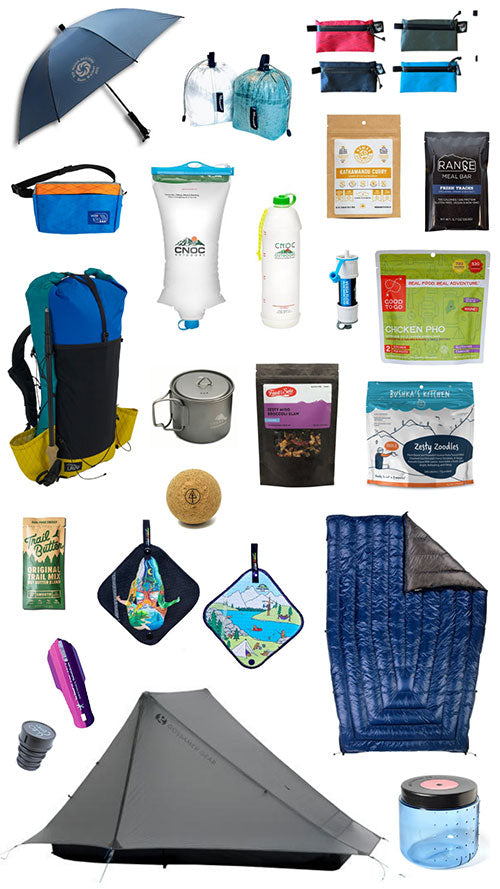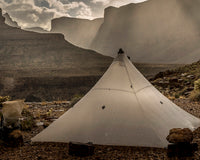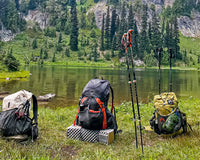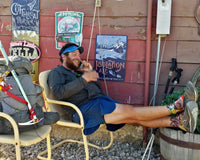
If you’ve spent any time in the great outdoors camping or backpacking, you’ve heard this phrase: A fed bear is a dead bear. But have you taken the time to understand the gravity of what this means? It’s our job as humans to educate ourselves to protect wildlife. If we don’t, they pay the ultimate price. Bears are a vital component of their environment, so their survival has a big impact on the ecological systems they live in.
One of the best precautions we can take when spending the night in the wild is to secure our food, trash, and other scented items, like chapstick and toothpaste, in a bear canister.
How Bear Canisters Work

Bear canisters—or bear cans for short—are hard-sided containers with a locking lid that requires an opposable thumb, coin, or key to open them. This makes it near impossible for a bear to pop the top on the can and have a feast.
Tips for Using a Bear Can

- Keep it closed unless you’re getting something out or putting something in. DON’T leave it open while cooking. This is essentially inviting a bear, or other wildlife, to snag it and all its contents.
- Store it 100 feet downwind of your tent in black bear country and 300 feet downwind when in grizzly country.
- Choose a spot away from cliffs and water sources. Bears will often play with cans to try and get into them and the last thing you want is to have it tossed into a ravine or carried downstream.
- Avoid securing it up against hard rocks or roots that could get damaged if a bear placed its full weight on it.
- Consider placing something on top of your bear can to act as an alarm if a bear is going after it.
- Avoid attaching anything to the bear canister, which may allow the bear to carry it away
Why Bear Cans are Useful

Bears have an incredibly strong sense of smell. No canister is “smell proof,” though some are smell-resistant, which means bears can smell your food from 1-2 miles away. Think of that next time you bite into a Cliff Bar. But if they can’t access your food, they’ll get bored and go forage for themselves. We want to encourage that behavior.
What about a bear hang? That can be a viable option. If, however, you don’t master the hang, your efforts will be in vain. One thing to keep in mind when considering a bear can vs. a hang is that bears are very smart creatures. They have learned to send cubs up a tree and onto branches to either chew through the cord or snap the branch to retrieve food bags.
A 2019 Outside Magazine article written by Andrew Skurka argues that ‘Bear Hangs are Ineffective.’ And a recent Backpacker Magazine article titled, ‘Is It Time to Retire the Bear Hang for Good?’ interviews experts who agree hanging food is an outdated approach.

For this reason, it’s a good idea to consider using a bear can instead of trying a bear hang, especially if, like me, you aren’t experienced with hangs and don’t feel confident you’ll nail it. Better safe than sorry here.
(Here at GGG, we’ll be publishing an article in coming weeks about the Ursack + Opsak option for storing food and scented items in the backcountry. Stay tuned.)
Where Bear Cans are Required

If you’re hiking in specific areas, you may be surprised to find out that bear cans aren’t just recommended but required. Most ranger stations will have cans available to rent for a small fee if you don’t have your own, but double-check online or by calling before you embark on your trip. Here’s a quick list* of parks in the US that require you to carry cans by state.
- Alaska – Gates of the Arctic National Park: all treeless areas, canister rent is FREE
- California – Yosemite National Park: entire backcountry, Sequoia/ Kings Canyon National Park: selected areas from May 1 – October 31, Inyo National Forest: selected areas, Desolation Wilderness: selected areas within Eldorado National Forest and year-round in Lake Tahoe, Lassen Volcanic National Park: entire backcountry from April 16 – November 30
- Colorado – Rocky Mountain National Park: entire backcountry below tree line from May 1 – Oct 31
- New York – The Adirondack Mountains Eastern High Peaks Wilderness: entire backcountry between April 1 – November 30
- Washington – Olympic National Park: selected areas, North Cascades National Park: selected areas from June 1 – November 15
- Wyoming – Grand Teton National Park: entire backcountry unless food lockers are in place
*Park regulations are subject to change, so do your research on the one you intend to visit before you get there. If a can is required and you don’t have one and they aren’t available to rent, you could be out of luck.
Curious about the date specifications? It’s due to our furry friends’ hibernation schedules. Fun fact: Bears do not experience bone density loss despite being in a non-weight-bearing position for months on end! How? They’re able to recycle calcium back into their bones. Cool, right?
How to Pack a Bear Can

To get the most space out of your bear can, it’s highly recommended to repackage the food you intend to bring. You’ll save a lot of space by transferring food into Ziplock bags that you squeeze the air out of to create what I like to call a poor man’s vacuum seal.
Another great idea is to pack your food in order by how you intend to eat it, placing the food to be consumed last at the bottom. This helps you avoid endless digging and reorganizing when you’re hungry. Also, keep in mind you are allowed to keep the first day’s food out of your can, but everything else that has a scent, including trash, needs to be packed into your can.
I’ve personally used BearVault’s BV500 when backpacking, and once you get the hang of the lock, it’s a piece of cake. Unfortunately, due to my mistake, it tumbled down a ravine into a river on our way out of a backpacking trip in the Sierra. I’ll never see it again, but a bear won’t be able to access its contents either.
Where to Pack Your Bear Can

There are a few ways to carry your canister, so you can play around with which setup works best for you. You can pack it inside, on top, or underneath your backpack.
Inside a framed pack: To keep the weight centered and balanced, pack it in the center. Vertically or horizontally is fine, whichever feels better and accommodates the rest of your gear. Pack lighter gear first, such as your sleeping bag, and put the bear can on top of that before packing the rest of your gear around it.
Under a Y-strap: If you can’t fit your can inside your pack, and you have a Y-strap, secure it to the top of your pack using the strap. Most canisters have grooves and bumps to prevent sliding, but for some, this method doesn’t feel as secure or throws off your balance.
Under a pack lid or brain: Full disclosure, this is how I lost my canister, but I’m positive it was user error. This method can keep the canister snug and in place if the lid of your pack is large enough to fit around the outer edges of the bear can. Make sure you pull the straps tight!
Underneath a pack: High-volume packs tend to have straps for a sleeping pad or tent at the base of them. If they’re long enough, you can secure your canister with these straps as well.
Bottom Line

At the end of the day, bear cans are the best, most foolproof way to protect wildlife and yourself. Humans are the problem, not bears. They’re simply after the food that requires the least effort to get. It’s up to us to ensure that we take all necessary measures to keep wildlife wild. Also, a bear canister doubles as a seriously good camp stool, so bonus!
Rachel is a writer, backpacker, and performer who has dreams of thru-hiking the PCT and finally getting a trail name. She currently enjoys providing trail magic during peak season for PCT hikers in the Los Angeles area.

















4 comments
Brittany Smith
This was a great read! I personally love my BearVault. I have two that I alternate between depending on the trip. They are strong, sturdy, and pretty darn lightweight for how protective they are. Super easy to use and I will be a customer for life. Highly recommend!!!
Brittany
I certainly agree with you Darold that those garcia cans are pretty indestructible but you also pay for it in weight/bulk. I think the weight to volume ratio is at least 20% better with the BearVault. Plus, my BV500 is going on 10 years old and still going strong. I’m pretty sure the bearvault is discouraged in the ADK but its definitely not banned. I’ve carried it up there two summers ago without issue.
Darold Petty
The original, and still best canister is the Garcia ‘Backpackers Cache’. It is slightly more heavy than bearvault, but indestructible. I own two, now more than 20 years old, and they are still in perfect condition.
BT
Unfortunately, these Bearvaults are banned in the Adirondack Mountains. Local black bears have learned how to pop these open. Heavier duty canisters are required.